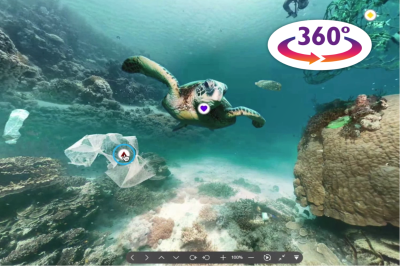At one time or another, most teachers will experience a lack of student motivation in the classroom. This is especially true following the Covid-19 pandemic. The sudden shift from in-person to online learning caused many disruptions within the English language classroom. However, it also highlighted the benefits of teaching with technology in our increasingly digital world. Our paper on Using Technology to Motivate Learners found that technology can have a positive impact on student motivation.
In this article, you will find 5 ways to boost motivation by teaching with technology. We will also highlight some of the ways OUP can support you, such as through our 360° Interactive Image feature designed to seamlessly introduce technology into the English language classroom.
How can technology motivate learners?
By teaching your students to learn with technology, you hand them the tools for life-long and life-wide learning both inside and outside the classroom. Technology can improve student motivation by:
1. Enabling situated learning: Technology is becoming an increasingly important part of many students’ lives. When you incorporate technology into your lessons, you show students that learning can take place anywhere, including the digital spaces they interact with daily.
2. Offering wide English exposure: Digital learning introduces students to language in a variety of entertaining and engaging contexts. They can learn English through interacting with webpages, games, articles, videos, and many more authentic, real-world resources.
3. Personalizing learning: Many digital learning spaces, such as websites and e-books, incorporate a wide variety of interactive media and activities. This gives students enough space to explore each environment using their unique interests and experiences as a guide.
4. Teaching autonomy and competence: While exploring digital spaces, students learn to make decisions and create meaning. In doing so, they gain skills, such as digital literacy and autonomy, that will help them sustain their own learning.
5. Supporting social learning: In the age of social media, many students form social connections online as well as face-to-face. You can plan fun, socially relevant lessons by incorporating technology into group activities or encouraging students to interact within digital learning spaces. This also creates an opportunity to teach your students internet safety and productive digital socialization.
How can OUP support me in the classroom? 
On our PD homepage, we offer a broad range of professional development resources in a variety of formats. Our Digital Literacies module supports you in teaching with technology and expanding your own digital literacies. We have also designed coursebooks with digital features intended to support the seamless introduction of technology into your English language curriculum.
For example, our 360° Interactive Image feature uses technology to improve student motivation in the classroom. Simple controls allow students to look around in any direction and explore locations ranging from the bottom of the ocean to the international space station. This unique form of situated learning teaches students to see the world around them as a learning space.
Hotspots click to reveal audio and video clips, articles, infographics, and more, offering students English language exposure in a wide variety of contexts. The images place students’ interests and experiences at the heart of learning by encouraging them to personalize their learning process and choose which media they will focus on. Along the way, they will gain skills in learner autonomy and digital literacy. Each image links to one of our coursebooks, providing students with group activities that support social learning. Finally, a Teacher’s Guide provides you with clear guidance on incorporating 360° Images into your lesson plans.
Learn more about 360° Interactive Images and take a free trial.
Stephanie Silva is an Assistant Marketing Manager at Oxford University Press. She joined the Press last year working on the Global Campaigns team within the English Language Teaching Division. She believes that language changes lives and stories inspire empathy and imagination




I’m fascinated by the latest tech trends and this post provides a great overview of what’s happening in the industry. Keep up the great work!